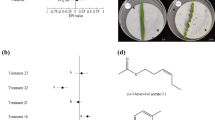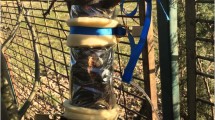Abstract
Trypophloeus klimeschi Eggers was first discovered in Xinjiang Province and had strong selection specificity for Populus alba var. pyramidalis Bunge. There was an outbreak of this beetle in the northwest shelter forest of China, resulting in significant economic losses and loss of ecological benefits. Based on a prior long-term field investigation, T. klimeschi had a different extent of injuries for different ages of P. alba var. pyramidalis and other Populus in the same area were not selected by T. klimeschi. To further explore the specificity volatile compounds, this study involved selecting host and non-host trees to analyse the volatile chemical profile of host and non-host poplars of T. klimeschi. The main volatile compounds of the host poplar P. alba var. pyramidalis for different physiological statuses and those of three other non-host poplars (P. alba L., P. tomentosa Carr., and P. dakuanensis Hsu) were analysed through solid-phase micro extraction (SPME) coupled with thermal desorption and gas chromatography-mass spectrometry (GC-MS). The major compound groups were aldehydes, esters, alcohols, ketones, phenols, terpenes and alkanes. Comparative analysis of the changes in the different physiological stages of P. alba var. pyramidalis and other non-host Populus volatile substances was conducted, and the results showed that 2-hydroxy-benzaldehyde, nonanal, decanal, 2-methyl-butanal, (Z)-3-hexen-1-ol benzoate, methyl benzoate, methyl salicylate, geraniol and salicyl alcohol might act as attractants for T. klimeschi, and 2-hexenal, hexanal, 2-cyclohexen-1-one, caryophyllene, eugenol, benzyl alcohol, and eucalyptol could be deterrents for T. klimeschi. These experiments may lead to the optimisation of a synthetic lure that may be used to detect and monitor T. klimeschi.
Similar content being viewed by others
Abbreviations
- SPME:
-
solid phase micro extraction
- GC-MS:
-
gas chromatography-mass spectrometry
- DBH:
-
diameter at breast height
- VOCs:
-
volatile compounds
References
Cao, Y., Luo, Z., Wang, S., and Zhang, P., Bionomics and control of Trypophloeus klimeschi, Entomol. Knowledge, 2004, vol. 41, pp. 36–38.
Clavijo, M.A., Irmisch, S., Reinecke, A., Boeckler, G.A., Veit, D., Reichelt, M., and Unsicker, S.B., Herbivoreinduced volatile emission in black poplar: regulation and role in attracting herbivore enemies, Plant Cell Environ., 2014, vol. 37, pp. 1909–1923.
Jerkovic, I. and Mastelic, J., Volatile compounds from leaf-buds of Populus nigra L. (Salicaceae), Phytochemistry, 2003, vol. 63, pp. 109–113.
Guo, X., Yuan, G., Jiang, J., Luo, M., and Ma, J., Chemical components of volatiles form withered black poplar leaves with different physiological age, Chin. J. Appl. Ecol., 2005, vol. 16: 1822.
Kessler, A. and Baldwin, I.T., Defensive function of herbivore-induced plant volatile emissions in nature, Science, 2001, vol. 291, pp. 2141–2144.
Tansey, J.A., McClay, A.S., Cole, D.E., and Keddie, B.A., Evidence for the influence of conspecific chemical cues on Aphthona nigriscutis (Coleoptera: Chrysomelidae) behaviour and distribution, Biocontol, 2005, vol. 50, pp. 343–358.
Heath, R.R., Landolt, P.J., Dueben, B., and Lenczewski, B., Identification of floral compounds of night-blooming jessamine attractive to cabbage looper moths, Environ. Entomol., 1992, vol. 21, pp. 854–859.
Ling, N., Tang, J.G., Yin, Y.S., Zhang, F., An, Y.L., Jiangyin, E.E.I., and Jiangsu, E.E.I., Electroantennogram responses of Clostera anastomosis adults to plant volatile of Populus nigra, Jiangsu J. Agric. Sci., 2014, vol. 3, pp. 514–519.
Leal, W.S., Barbosa, R.M., Xu, W., Ishida, Y., Syed, Z., Latte, N., and Furtado, A., Reverse and conventional chemical ecology approaches for the development of oviposition attractants for Culex mosquitoes, PloS One, 2008, vol. 3, no. 8: e3045.
Arnaud, L., Lognay, G., Verscheure, M., Leenaers, L., Gaspar, C., and Haubruge, E., Is dimethyldecanal a common aggregation pheromone of Tribolium flour beetles? J. Chem. Ecol., 2002, vol. 28, pp. 523–532.
Morawo, T. and Fadamiro, H., Identification of key plant-associated volatiles emitted by Heliothis virescens, larvae that attract the parasitoid, Microplitis croceipes: implications for parasitoid perception of odor blends, J. Chem. Ecol., 2016, vol. 42, pp. 1–10.
Croft, K., Juttner, F., and Slusarenko, A.J., Volatile products of the lipoxygenase pathway evolved from Phaseolus vulgaris leaves inoculated with Pseudomonas syringae pv. phaseolicola, Plant Physiol., 1993, vol. 101, pp. 13–24.
Zhang, J., Tian, H., Sun, H., and Wang, X., Antifungal activity of trans-2-hexenal against Penicillium cyclopium by a membrane damage mechanism, J. Food Biochem., 2017, vol. 41, pp. 12–19.
Chen, Y., Analyzing blends of herbivore-induced volatile organic compounds with factor analysis: revisiting “cotton plant, Gossypium hirsutum L. defense in response to nitrogen fertilization,” J. Econ. Entomol., 2013, vol. 106, pp. 1053–1057.
Prokopy, R.J., Hu, X., Jang, E.B., Vargas, R.I., and Warthen, J.D., Attraction of mature Ceratitis capitata, females to 2-heptanone, a component of coffee fruit odor, J. Chem. Ecol., 1998, vol. 24, pp. 1293–1304.
Dudareva, N., Murfitt, L.M., Mann, C.J., Gorenstein, N., Kolosova, N., Kish, C.M., and Wood, K., Developmental regulation of methyl benzoate biosynthesis and emission in snapdragon flowers, Plant Cell, 2000, vol. 12, pp. 949–961.
Deng, S.S., Yi, J., Cao, Y.Z., Luo, Z.X., Wang, W., and Li, K.B., Electroantennographic and behavioral responses of Holotrichia oblita to plant volatiles, Plant Prot., 2011, vol. 37, pp. 62–66.
Boch, R. and Shearer, D.A., Identification of geraniol as the active component in the Nassanoff pheromone of the honey bee, Nature, 1962, vol. 194, pp. 704–706.
Chinta, S., Dickens, J.C., and Aldrich, J.R., Olfactory reception of potential pheromones and plant odors by tarnished plant bug, Lygus lineolaris (Hemiptera: Miridae), J. Chem. Ecol., 1994, vol. 20, pp. 3251–3267.
Prates, H.T., Santos, J.P., Waquil, J.M., Fabris, J.D., Oliveira, A.B., and Foster, J.E., Insecticidal activity of monoterpenes against Rhyzopertha dominica (F.) and Tribolium castaneum (Herbst), J. Stored Prod. Res., 1998, vol. 34, pp. 243–249.
Gouinguené, S.P. and Turlings, T.C.J., The effects of abiotic factors on induced volatile emissions in corn plants, Plant Physiol., 2002, vol. 129, pp. 1296–1307.
Huang, Y., Ho, S.H., Lee, H.C., and Yap, Y.L., Insecticidal properties of eugenol, isoeugenol and methyleugenol and their effects on nutrition of Sitophilus zeamais Motsch. (Coleoptera: Curculionidae) and Tribolium castaneum (Herbst) (Coleoptera: Tenebrionidae), J. Stored Prod. Res., 2002, vol. 38, pp. 403–412.
Xiao, C., Luo, F., and Wang, H.Y., Attraction of cotton bollworm, Helicoverpa armigera to o-hydroxybenzyl alcohol in field, Entomol. Knowledge, 2002, vol. 39, pp. 303–304.
Kobayashi, T., Nishimura, K., and Fujita, T., Effects of the a-cyano group in the benzyl alcohol moiety on insecticidal and neurophysiological activities of pyrethroid esters, Pestic. Biochem. Phys., 1989, vol. 35, pp. 231–243.
Rudinsky, J.A. and Michael, R.R., Sound production in Scolytidae: 'rivalry' behaviour of male Dendroctonus beetles, J. Insect. Physiol., 1974, vol. 20, pp. 1219–1230.
Pureswaran, D.S. and Borden, J.H., New repellent semiochemicals for three species of Dendroctonus (Coleoptera: Scolytidae), Chemoecology, 2004, vol. 14, pp. 67–75.
Devi, K.P., Nisha, S.A., Sakthivel, R., and Pandian, S.K., Eugenol (an essential oil of clove) acts as an antibacterial agent against Salmonella typhi by disrupting the cellular membrane, J. Ethnopharmacol., 2010, vol. 130, pp. 107–115.
Chami, N., Bennis, S., Chami, F., Aboussekhra, A., and Remmal, A., Study of anticandidal activity of carvacrol and eugenol in vitro and in vivo, Oral Microbiol. Immun., 2005, vol. 20, pp. 106–111.
Flores, N., Jiménez, I.A., Giménez, A., Ruiz, G., Gutiérrez, D., Bourdy, G., and Bazzocchi, I.L., Benzoic acid derivatives from Piper species and their antiparasitic activity, J. Nat. Prod., 2008, vol. 71, pp. 1538–1543.
Pei, H.L., Determination on isopropyl salicylate antibacterial activity in vitro, J. Anhui Agric. Sci., 2008, vol. 34: 013.
Author information
Authors and Affiliations
Corresponding author
Additional information
The article is published in the original.
Supplementary materials are available for this article at doi 10.1134/S1021443718060067 and are accessible for authorized users.
Electronic supplementary material
11183_2018_7045_MOESM1_ESM.pdf
Volatile Organic Compound Analysis of Host and Non-host Poplars for Trypophloeus klimeschi (Coleoptera: Curculionidae: Ipinae)
Rights and permissions
About this article
Cite this article
Gao, G., Dai, L., Gao, J. et al. Volatile Organic Compound Analysis of Host and Non-Host Poplars for Trypophloeus klimeschi (Coleoptera: Curculionidae: Ipinae). Russ J Plant Physiol 65, 916–925 (2018). https://doi.org/10.1134/S1021443718060067
Received:
Published:
Issue Date:
DOI: https://doi.org/10.1134/S1021443718060067




